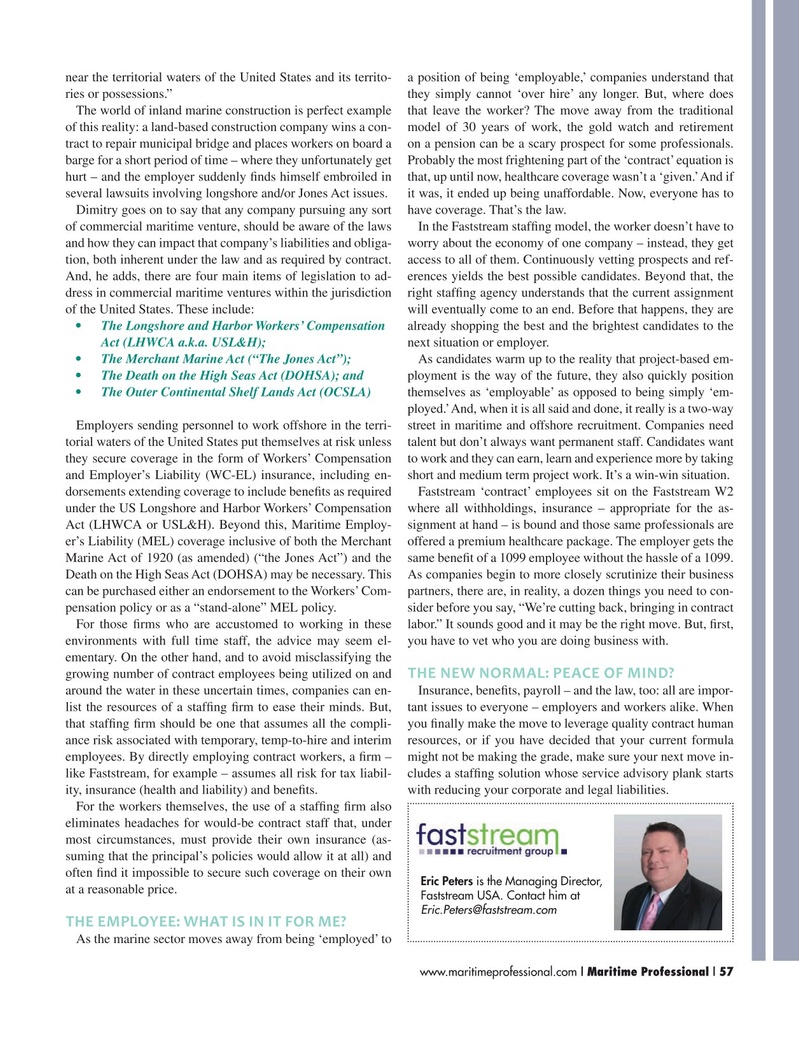
Page 57: of Maritime Logistics Professional Magazine (Q3 2015)
Read this page in Pdf, Flash or Html5 edition of Q3 2015 Maritime Logistics Professional Magazine
near the territorial waters of the United States and its territo- a position of being ‘employable,’ companies understand that ries or possessions.” they simply cannot ‘over hire’ any longer. But, where does
The world of inland marine construction is perfect example that leave the worker? The move away from the traditional of this reality: a land-based construction company wins a con- model of 30 years of work, the gold watch and retirement tract to repair municipal bridge and places workers on board a on a pension can be a scary prospect for some professionals. barge for a short period of time – where they unfortunately get Probably the most frightening part of the ‘contract’ equation is hurt – and the employer suddenly ? nds himself embroiled in that, up until now, healthcare coverage wasn’t a ‘given.’ And if several lawsuits involving longshore and/or Jones Act issues. it was, it ended up being unaffordable. Now, everyone has to
Dimitry goes on to say that any company pursuing any sort have coverage. That’s the law.
of commercial maritime venture, should be aware of the laws In the Faststream staf? ng model, the worker doesn’t have to and how they can impact that company’s liabilities and obliga- worry about the economy of one company – instead, they get tion, both inherent under the law and as required by contract. access to all of them. Continuously vetting prospects and ref-
And, he adds, there are four main items of legislation to ad- erences yields the best possible candidates. Beyond that, the dress in commercial maritime ventures within the jurisdiction right staf? ng agency understands that the current assignment of the United States. These include: will eventually come to an end. Before that happens, they are • The Longshore and Harbor Workers’ Compensation already shopping the best and the brightest candidates to the Act (LHWCA a.k.a. USL&H); next situation or employer.
• The Merchant Marine Act (“The Jones Act”); As candidates warm up to the reality that project-based em- • The Death on the High Seas Act (DOHSA); and ployment is the way of the future, they also quickly position • The Outer Continental Shelf Lands Act (OCSLA) themselves as ‘employable’ as opposed to being simply ‘em- ployed.’ And, when it is all said and done, it really is a two-way
Employers sending personnel to work offshore in the terri- street in maritime and offshore recruitment. Companies need torial waters of the United States put themselves at risk unless talent but don’t always want permanent staff. Candidates want they secure coverage in the form of Workers’ Compensation to work and they can earn, learn and experience more by taking and Employer’s Liability (WC-EL) insurance, including en- short and medium term project work. It’s a win-win situation.
dorsements extending coverage to include bene? ts as required Faststream ‘contract’ employees sit on the Faststream W2 under the US Longshore and Harbor Workers’ Compensation where all withholdings, insurance – appropriate for the as-
Act (LHWCA or USL&H). Beyond this, Maritime Employ- signment at hand – is bound and those same professionals are er’s Liability (MEL) coverage inclusive of both the Merchant offered a premium healthcare package. The employer gets the
Marine Act of 1920 (as amended) (“the Jones Act”) and the same bene? t of a 1099 employee without the hassle of a 1099.
Death on the High Seas Act (DOHSA) may be necessary. This As companies begin to more closely scrutinize their business can be purchased either an endorsement to the Workers’ Com- partners, there are, in reality, a dozen things you need to con- pensation policy or as a “stand-alone” MEL policy. sider before you say, “We’re cutting back, bringing in contract
For those ? rms who are accustomed to working in these labor.” It sounds good and it may be the right move. But, ? rst, environments with full time staff, the advice may seem el- you have to vet who you are doing business with.
ementary. On the other hand, and to avoid misclassifying the growing number of contract employees being utilized on and THE NEW NORMAL: PEACE OF MIND?
around the water in these uncertain times, companies can en- Insurance, bene? ts, payroll – and the law, too: all are impor- list the resources of a staf? ng ? rm to ease their minds. But, tant issues to everyone – employers and workers alike. When that staf? ng ? rm should be one that assumes all the compli- you ? nally make the move to leverage quality contract human ance risk associated with temporary, temp-to-hire and interim resources, or if you have decided that your current formula employees. By directly employing contract workers, a ? rm – might not be making the grade, make sure your next move in- like Faststream, for example – assumes all risk for tax liabil- cludes a staf? ng solution whose service advisory plank starts ity, insurance (health and liability) and bene? ts. with reducing your corporate and legal liabilities.
For the workers themselves, the use of a staf? ng ? rm also eliminates headaches for would-be contract staff that, under most circumstances, must provide their own insurance (as- suming that the principal’s policies would allow it at all) and often ? nd it impossible to secure such coverage on their own
Eric Peters is the Managing Director, at a reasonable price.
Faststream USA. Contact him at
THE EMPLOYEE: WHAT IS IN IT FOR ME?
As the marine sector moves away from being ‘employed’ to www.maritimeprofessional.com | Maritime Professional | 57 50-63 Q3 MP2015.indd 57 9/18/2015 11:10:46 AM

 56
56

 58
58
